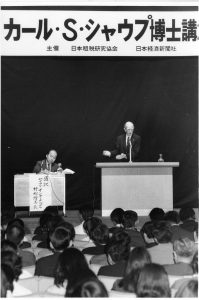We recently received some materials from Ellen Ruth Mayer, whose grandfather was former Emeritus Professor of Economics Carl Shoup. The records offer a personal record of the Shoup Tax Mission to Japan in 1949-1950 and its continuing legacy. These are now available to researchers as part of the Department of Economics records.

After earning a journalism degree at Stanford University in 1924, Carl Sumner Shoup came to New York City to become a newspaperman. Fortunately, he soon found another interest: he started taking courses in economics at Columbia and, by 1928, he was an instructor while working on his dissertation on the French tax system. In the 1930s, Shoup led multiple studies of the federal tax system for the Treasury Department. As the leading tax expert, he was tapped by Harold Moss, aide to General Douglas MacArthur, to help overhaul the tax system in Japan.
For the Tax Mission to Japan, Shoup was able to recruit his own team: William Vickrey, Stanley Surrey, William Warren and Howard Bowen, assistants Jerome B. Cohen and Rolland Hatfield and, by special appointment as a tax economist, Martin Bronfenbrenner. The team also included three public finance economists from Japanese universities: Ito Hanya, Shiomi Sabaru, and Tsuru Shigeto. For four months in the summer of 1949 (and again in 1950), Shoup and his team traveled across Japan to learn about the tax system and how it was perceived. He wanted to create a tax system that was fair and simple for both individuals and corporations. At first, the team members were treated like celebrities: staying at the Imperial Hotel and followed by a team of reporters, with multiple press conferences and non-stop events. Eventually, they were able to travel by train on their own and to meet “with Japanese businessmen, and with the Japanese common man, in the farm fields, and even down in the mines … We made unscheduled interviews with men working at the blast furnaces in a steel mill, with owner operators of little machine shops, with clerks in department stores, and also with well-to-do industrialists and bankers.”

The tax mission report became an instant classic: there were over 20,000 copies printed of the 4 volumes in English and Japanese. The Shoup Tax Mission’s proposals were enacted into law almost in their entirety by the Japanese Diet in 1950 and remained mostly intact for decades after. In 1986, when the Japanese Minister of Finance Noboru Takeshita received an honorary degree at Columbia, he mentioned Japan’s close ties to the University thanks to the “Shoup recommendations” as they were still known, “which enabled the country to recover from the war and achieve high economic growth.” A few years later, in 1991, Columbia received a $2 million gift from Toyota Motor Corp. to create a professorship honoring Shoup, “whose advice on tax reform was a critical element in Japan’s post-war recovery.” Shoup was decorated twice by Japan’s Emperor Hirohito with the Order of the Sacred Treasure.
In December 2021, thanks to Ellen Ruth Mayer, we received the newly accessible Shoup Tax Mission to Japan records. These include the original correspondence from Carl to his wife Ruth; copies of the final report of the Mission; and three albums of photographs. There are also some newspaper clippings in English and in Japanese, photographs, negatives and color slides. These records document the days of the team traveling throughout Japan and the later anniversary celebrations. We are grateful for this valuable addition to our collections.